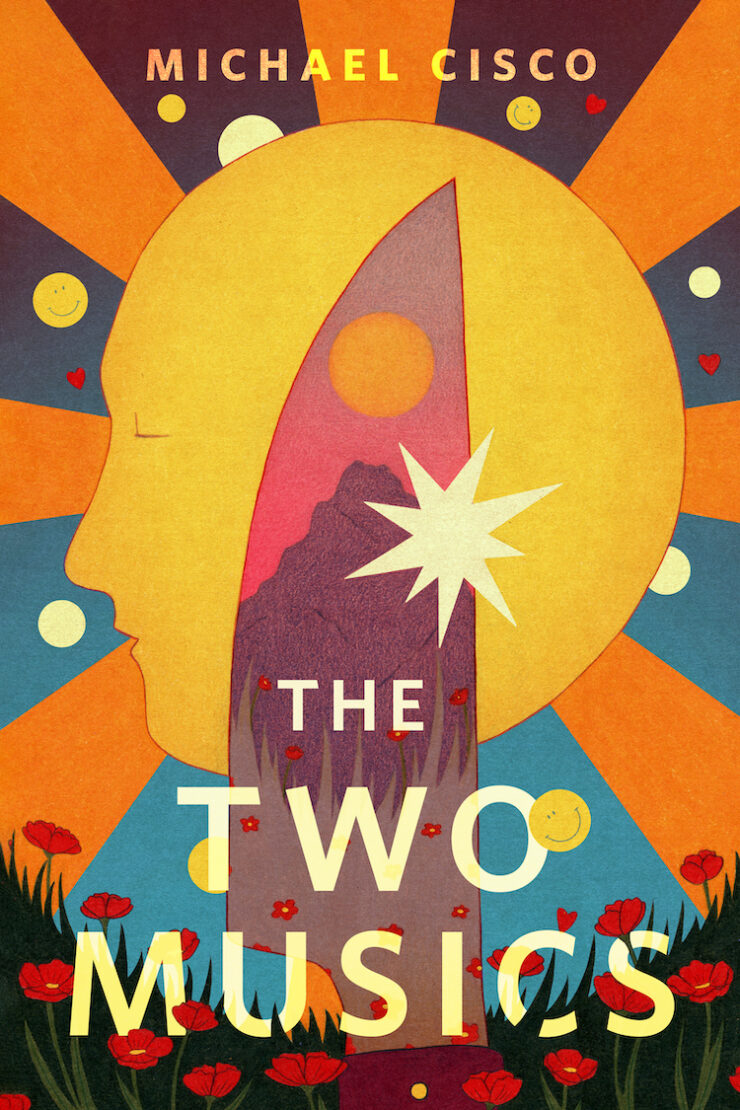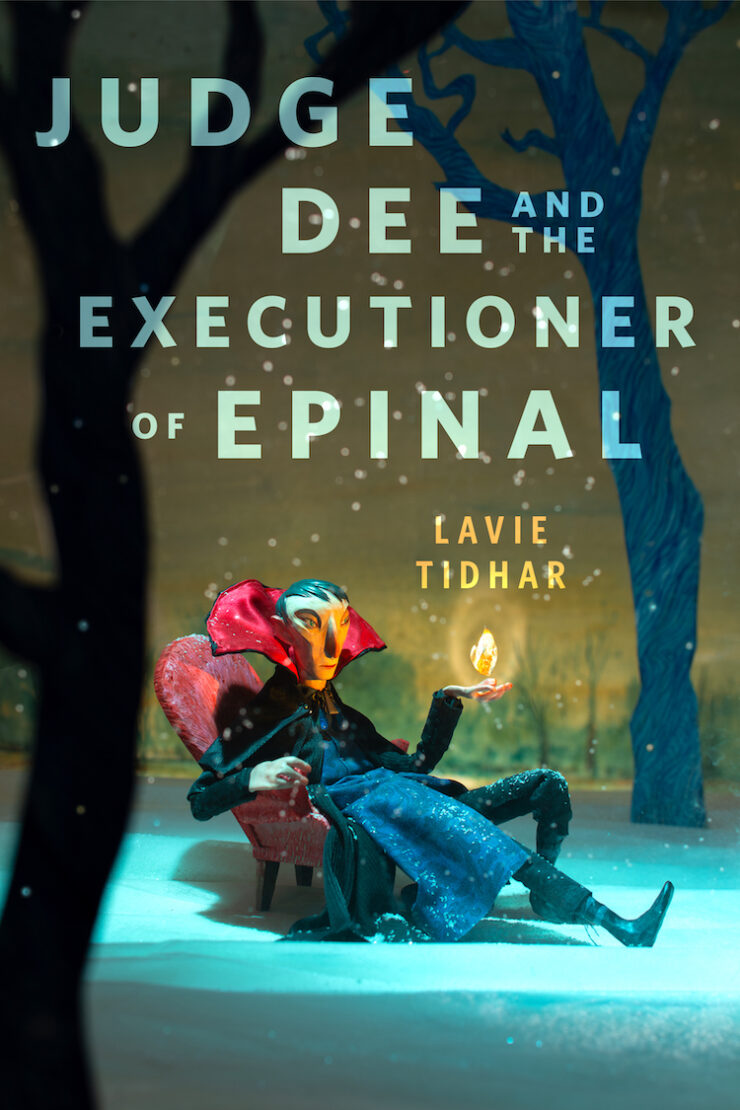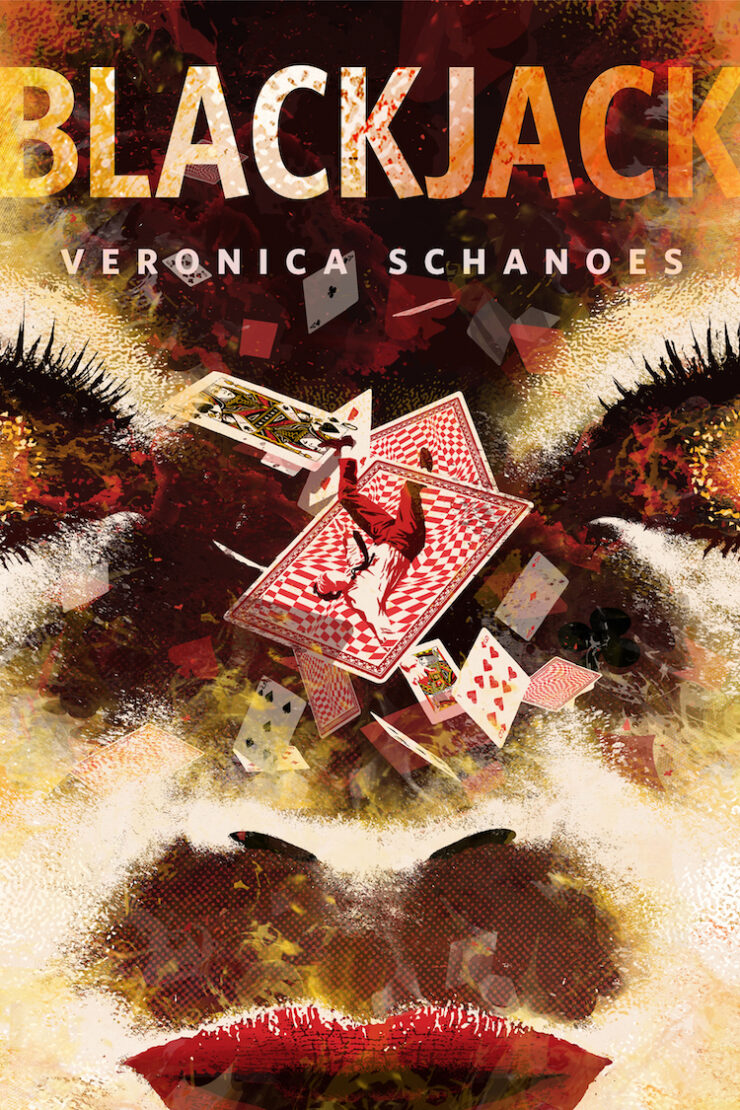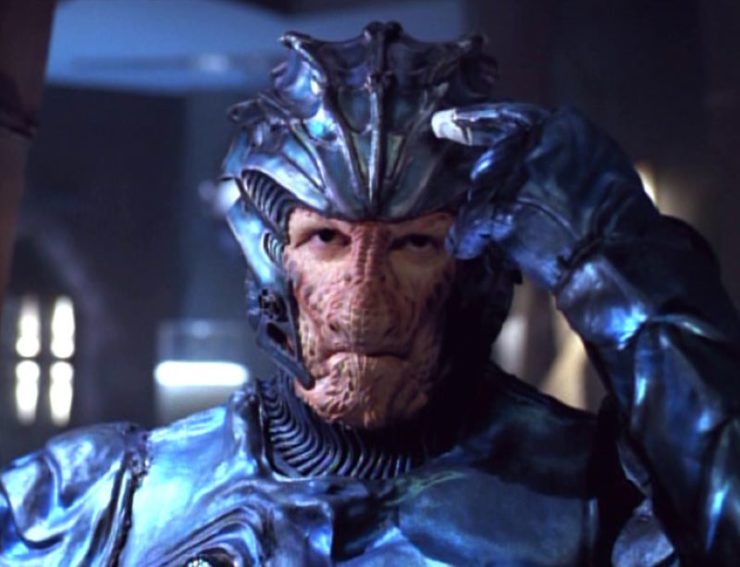“Prey”
Written by Brannon Braga
Directed by Allan Eastman
Season 4, Episode 16
Production episode 184
Original air date: February 18, 1998
Stardate: 51652.3
Captain’s log. A Hirogen ship is chasing a bioship belonging to Species 8472. The two Hirogen track the lone creature to an asteroid where they finally corner it and shoot it to smithereens.
Voyager later comes across the same Hirogen ship, but it’s adrift with only one lifesign aboard. Against Seven’s loud recommendation, Janeway sends an away team over consisting of Chakotay, Tuvok, and Paris. They find a trophy room similar to the one Tuvok and Seven were imprisoned in last time, and Paris at one point comes across what he thinks is a helmet, but it turns out to still have the decapitated head of the beta Hirogen in it, scaring the bejabbers out of him.
They find the alpha, wounded, and beam him to Voyager‘s sickbay.
Chakotay and Tuvok are able to access the Hirogen’s computer, and they know a lot more about them now: They’re nomadic, with no single homeworld, and the hunt is the most important aspect of their society. Status is conferred by the quality of one’s prey and the difficulty level of a hunt.
The alpha regains consciousness in sickbay and refuses treatment. His immune system is powerful enough to resist every sedative in the EMH’s pharmacopeia. Janeway talks to him, convinces him that they’re trying to help and that he’ll die without treatment. Wanting to return to the hunt, the alpha allows himself to be treated.
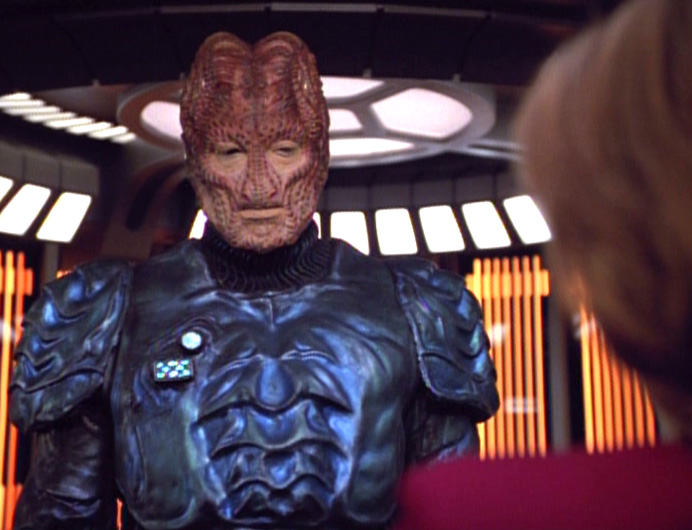
Tuvok and Kim investigate a hull breach, which they thought was an overload, but the hull has been ripped open, and there’s blood. Examination of the blood reveals that it’s a fluidic lifeform, likely Species 8472, who are impervious to Starfleet sensors. Voyager goes on intruder alert. 8472 attacks engineering, wounding Torres.
The alpha says that 8472 is his prey. He’d thought he’d killed it, but it was more resilient than expected, broke free of its bonds on the Hirogen ship, killed the beta, and wounded the alpha. The Hirogen had been tracking it for fifty light-years. Other Hirogen ships are on their way to join the hunt. Janeway agrees to let the alpha join the hunt for the creature if he calls off his fellows. The alpha agrees.
Buy the Book
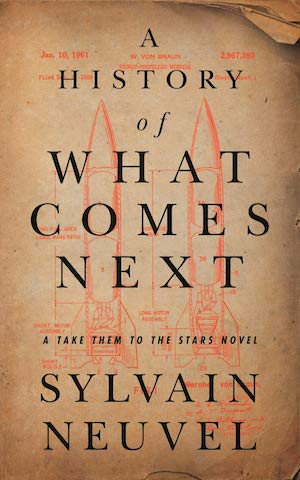

A History of What Comes Next
8472 is hunkered down on deck eleven, and has killed life support and artificial gravity. Tuvok has evacuated the deck, and he, Seven, Chakotay, Paris, and the alpha (all but the Hirogen in EVA suits with magnetic boots) patrol the deck in search of the creature. They find it near deflector control, wounded and barely moving. Tuvok has to stun the alpha to keep him from killing 8472, while 8472 also makes telepathic contact with Tuvok.
It becomes clear that 8472 is wounded, and was going to the deflector dish to open a singularity to get itself to fluidic space. It has no enmity toward anyone, it just wants to go home. Janeway wishes to send it home, thus pissing off the alpha (who is now again behind a force field in sickbay) and the other Hirogen. Worse, Seven is the only one with the skill to open a singularity, and she refuses to do so, as it is giving aid and comfort to the enemy.
Janeway confines Seven to the cargo bay and assigns Torres to figure out how to open a singularity. The Hirogen move to attack Voyager, as Janeway has declared the hunt of 8472 over, thus making Voyager their new target. The Hirogen attack, at one point temporarily disabling the force fields long enough for the alpha to escape sickbay.
Seven is allowed to leave the cargo bay to help defend the ship against the Hirogen. The alpha goes to where 8472 is recuperating, and attacks it. Seven accesses the transporter and beams both the alpha and 8472 to one of the Hirogen ships. The Hirogen all retreat.
Janeway is livid at Seven for disobeying orders. Seven points out the logical fallacy of Janeway trying to make Seven become more individual and then punishing her for having a mind of her own, but Janeway reminds her that there’s still a hierarchy on Voyager.
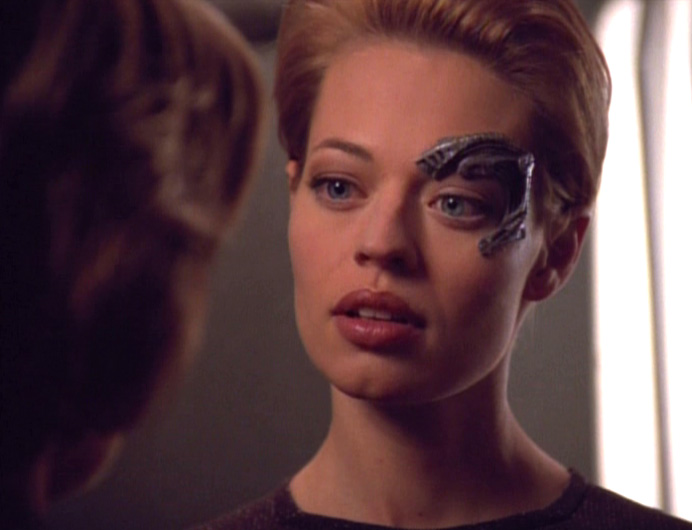
Can’t we just reverse the polarity? Torres finds herself incapable of opening a singularity using Voyager‘s engines. Apparently, in all this time, Seven never showed anyone how to do it.
There’s coffee in that nebula! Janeway rips Seven a new one for disobeying orders, though her very lax enforcement of the chain of command generally, especially with regards to Seven up until now in order to encourage her individuality, makes her insubordination perhaps a bit predictable.
Mr. Vulcan. Just as 8472 communicated with Kes telepathically in the “Scorpion” two-parter, it does likewise with Tuvok here.
Everybody comes to Neelix’s. At one point, Tuvok deputizes Neelix to join the security force, marking the third time we’ve seen Tuvok do this, but the first time he’s done so in a timeline that has remained intact. (The others were in “Before and After” and the “Year of Hell” two-parter, both due to the Krenim threat.)
Resistance is futile. Seven objects to sending an away team to the Hirogen ship given the risks, though she does later admit that the intel they gained was worth that risk. However, she absolutely refuses to do anything to help 8472, and not only refuses to obey Janeway’s order to help send it home, but takes over the transporter and sends 8472 to the Hirogen ship. (While Janeway says Seven has condemned 8472 to death, I’m not 100% convinced that it’s the Hirogen who will come out on top of that fight…)
Please state the nature of the medical emergency. The EMH is trying to help Seven, um, assimilate (sorry) into humanity by teaching her how to make small talk. He says it was a big help to him when he was first activated. Seven herself is a bit dubious as to the exercise’s efficacy, but she gives it a shot.
Do it.
“Surrender the creature to me, and you will not be harmed.”
“This isn’t a hunt, it’s a slaughter—and I’m calling it off right now.”
“We will not be denied our prey. Give us the creature or your crew will take its place.”
–The alpha setting terms, Janeway saying fuck you, and the alpha saying fuck you right back.
Welcome aboard. The big guest is the great Tony Todd in his third Trek role as the alpha Hirogen, having previously played Kurn in three episodes of TNG and one of DS9, as well as the older Jake Sisko in DS9’s “The Visitor.”
In addition, Clint Carmichael plays the ill-fated beta Hirogen. He previously played one of the Nausicaans who stabbed Ensign Jean-Luc Picard in the heart in TNG‘s “Tapestry.”
Trivial matters: In addition to continuing Voyager‘s encounters with the Hirogen following “Message in a Bottle” and “Hunters,” this episode also picks up on Species 8472 from “Scorpion, Part II.” The lone 8472 was left behind when its fellows retreated to fluidic space in that episode. How it then got more than 10,000 light-years away (since Voyager was sent that far at the end of “The Gift“) is left unclear.
That 8472 transits to this universe from fluidic space via singularities was established in the “Scorpion” two-parter.
The Hirogen will next be seen two episodes hence in the two-parter “The Killing Game.” Species 8472 will next be seen in the fifth season’s “In the Flesh.”
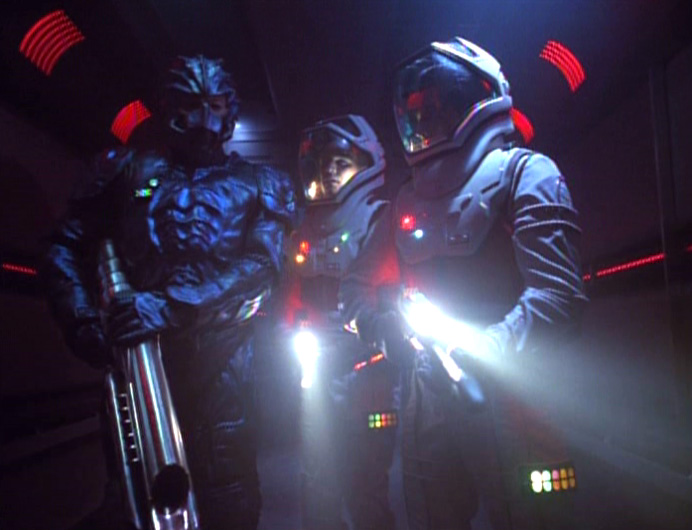
Set a course for home. “Your decision is tactically unsound.” This is another really powerful episode, continuing the superb introduction of the Hirogen as antagonists, with the added bonus of Tony Todd absolutely killing it as the alpha. In 2001, I wrote a Trek novel called Demons of Air and Darkness in which a Hirogen appeared, and I used Todd as the basis for the character, because he just nailed it.
The whole opening sequence is beautifully done, with Todd’s alpha strategizing and very obviously respecting 8472’s status as prey. And Todd’s superb performance continues throughout, as he never loses sight of his goal to capture 8472. Everything he does is in service of that, and I love how free of bluster the alpha is—he just wants to complete his hunt, nothing more, nothing less. I also like his matter-of-fact tactical analyses throughout.
A lot of people talk about this episode in terms of how it moves the Janeway-Seven relationship forward, and I actually think this is where the episode falls down a bit. Seven’s insubordination makes total sense, mind you. The Borg have no concept of compassion and their method of learning stuff is to assimilate the whole culture, so neither the initial away team nor Janeway’s later desire to send the wounded 8472 home make any sense to her at all. And her solution is a much nastier version of Scotty’s solution to the tribble infestation at the end of “The Trouble with Tribbles,” which is to send everyone off together on their own ship and fight it out.
But her conclusion at the end is completely off base. Janeway herself says that individuality only goes so far when there’s a hierarchical chain of command, but Seven’s riposte that Janeway is afraid of her individuality is given more air time and more weight, and a lame response by Janeway (“As you were”) makes it clear that the message the script wants to convey is that Seven’s right.
And she isn’t. Not even a little bit. Janeway isn’t frightened of Seven’s individuality; she simply disagreed with her. It’s not the first time she’s disagreed with a subordinate—she’s gone against the advice of the people under her command plenty of times, including that of her best friend and her trusted exec.
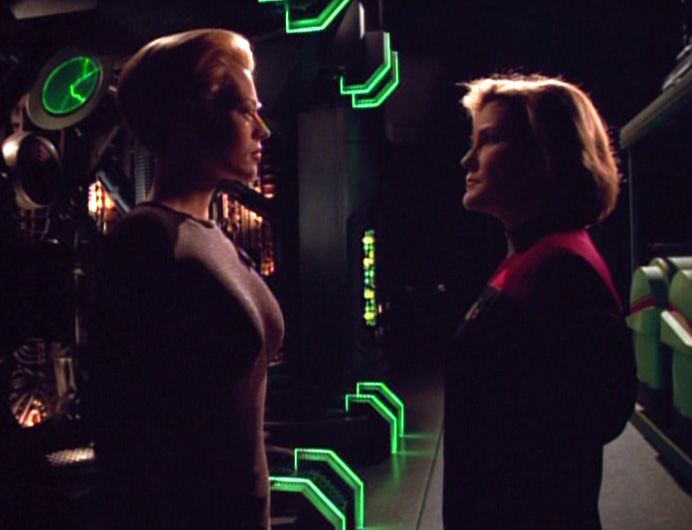
The real issue here is the one brought up by Torres in “Message in a Bottle” just two episodes ago: They’ve given Seven way too much latitude. They’re encouraging her individuality so much that they’re letting her get away with shit they shouldn’t be letting her get away with. In fact, in that very episode, Seven imperiously summons Janeway and Chakotay to astrometrics, and do the captain and first officer upbraid their subordinate for being so high-handed with the two people in charge? No, they laugh it off. That laxity is what led to Seven disobeying orders here.
Finally, often lost in the hugger-mugger about Janeway and Seven and the awesomeness of Tony Todd is the fact that this is another great episode for Chakotay. We get to see his inner anthropologist geek out over what he learns about the Hirogen, and then he has a great moment where he slaps down the alpha, saying that it’s his hunt. Robert Beltran plays it perfectly, with Chakotay using the Hirogen’s own cultural norms against him to reassert his own authority.
Note: There will be no Voyager Rewatch on Thursday the 26th due to the Thanksgiving holiday (though there will be a review of “Unification III,” this week’s Discovery episode, on that day). We’ll be back on Monday the 30th with “Retrospect.”
Warp factor rating: 9
Keith R.A. DeCandido‘s next novel is Animal, a thriller he wrote with Dr. Munish K. Batra, about a serial killer who targets people who harm animals. It’s now available for preorder, and if you preorder it directly from WordFire Press, you get a free urban fantasy short story by Keith.


